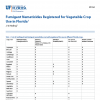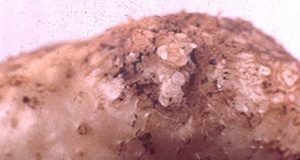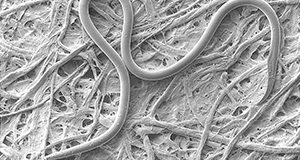Plant-parasitic nematodes pose a problem in agricultural systems by feeding on crops, therefore affecting their yield. Fluensulfone is a chemical that can be applied using various methods to manage the impact of plant-parasitic nematodes on crop production. This 6-page document discusses the characteristics and use of fluensulfone as a tool for nematode management practices. Written by Gilma X. Castillo, Monica Ozores-Hampton, and Pablo A. Navia Gine and published by the UF/IFAS Department of Horticultural Sciences, January 2018.
http://edis.ifas.ufl.edu/hs1313
Tag: Nematicides
Fumigant and Non-Fumigant Nematicides Labeled for Agronomic Crops in Florida
Plant-parasitic nematodes can cause severe yield loss of agronomic crops in Florida. Chemical products for managing plant-parasitic nematodes are called nematicides. This three-page facts heet describes the nematicides registered for use in Florida. Written by Zane Grabau and published by the Department of Entomology and Nematology.
http://edis.ifas.ufl.edu/in1152
Fumigant Nematicides Registered for Vegetable Crop Use in Florida (ENY064/IN980)
 This 3-page fact sheet lists of multispectrum fumigant nematicides currently registered for use on different Florida crops (Table 1); their maximum rates and specific details for field application (Table 2); and a generalized summary of maximum use rate and relative effectiveness of various soil fumigants for nematode, soilborne disease, and weed control in Florida (Table 3). Written by J. W. Noling, and published by the UF Department of Entomology and Nematology, January 2013.
This 3-page fact sheet lists of multispectrum fumigant nematicides currently registered for use on different Florida crops (Table 1); their maximum rates and specific details for field application (Table 2); and a generalized summary of maximum use rate and relative effectiveness of various soil fumigants for nematode, soilborne disease, and weed control in Florida (Table 3). Written by J. W. Noling, and published by the UF Department of Entomology and Nematology, January 2013.
http://edis.ifas.ufl.edu/in980
PI170/PI206 Carbofuran Cancellation Process
PI-170, a 4-page illustrated fact sheet by Frederick Fishel, provides a brief history of carbofuran’s use in the United States, describes risks associated with carbofuran use, and outlines the U.S. Environmental Protection Agency’s (EPA) stated rational for revoking its regulations that have allowed carbofuran residues in food. This publication also describes the EPA’s plans announced in 2008 to cancel the pesticide’s registration due to risks carbofuran poses to pesticide applicators and to birds in treated fields. Includes references. Published by the UF Department of Agronomy, August 2008.
http://edis.ifas.ufl.edu/PI206

